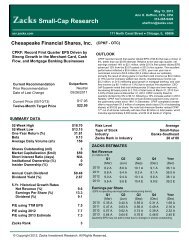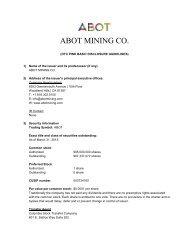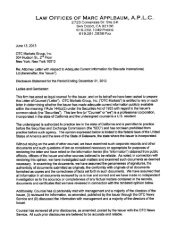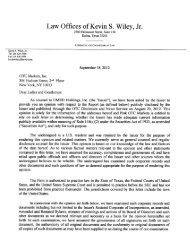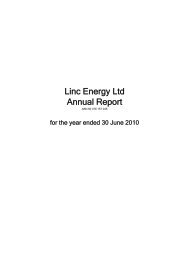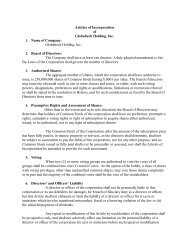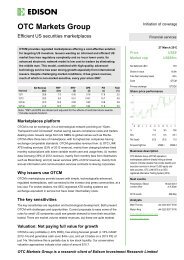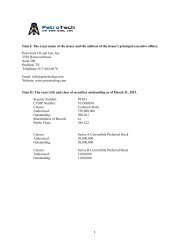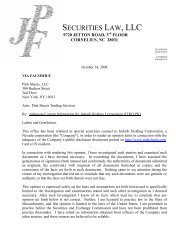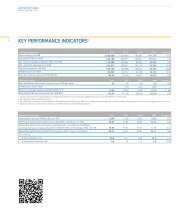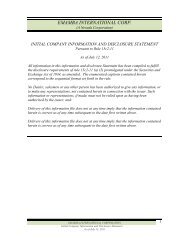2011 Annual Report - OTCIQ.com
2011 Annual Report - OTCIQ.com
2011 Annual Report - OTCIQ.com
Create successful ePaper yourself
Turn your PDF publications into a flip-book with our unique Google optimized e-Paper software.
82 Notes<br />
Recognition takes place at the beginning of the lease term<br />
at the lower of the fair value of the leased property or the<br />
present value of the minimum lease payments.<br />
The leased property is depreciated over its useful economic<br />
life or, if it is shorter, the term of the lease. The liability is subsequently<br />
measured using the effective interest method.<br />
All other transactions in which E.ON is the lessee are classified<br />
as operating leases. Payments made under operating leases<br />
are generally expensed over the term of the lease.<br />
Leasing transactions in which E.ON is the lessor and substantially<br />
all the risks and rewards incident to ownership of the<br />
leased property are transferred to the lessee are classified as<br />
finance leases. In this type of lease, E.ON records the present<br />
value of the minimum lease payments as a receivable. Payments<br />
by the lessee are apportioned between a reduction of the<br />
lease receivable and interest in<strong>com</strong>e. The in<strong>com</strong>e from such<br />
arrangements is recognized over the term of the lease using<br />
the effective interest method.<br />
All other transactions in which E.ON is the lessor are treated<br />
as operating leases. E.ON retains the leased property on its<br />
balance sheet as an asset, and the lease payments are generally<br />
recorded on a straight-line basis as in<strong>com</strong>e over the term<br />
of the lease.<br />
Financial Instruments<br />
Non-Derivative Financial Instruments<br />
Non-derivative financial instruments are recognized at fair<br />
value on the settlement date when acquired. Unconsolidated<br />
equity investments and securities are measured in accordance<br />
with IAS 39, “Financial Instruments: Recognition and Measurement”<br />
(“IAS 39”). E.ON categorizes financial assets as held for<br />
trading, available for sale, or as loans and receivables. Management<br />
determines the categorization of the financial assets<br />
at initial recognition.<br />
Securities categorized as available for sale are carried at fair<br />
value on a continuing basis, with any resulting unrealized<br />
gains and losses, net of related deferred taxes, reported as a<br />
<strong>com</strong>ponent of equity (other <strong>com</strong>prehensive in<strong>com</strong>e) until<br />
realized. Realized gains and losses are determined by analyzing<br />
each transaction individually. If there is objective evidence of<br />
impairment, any unrealized gains and losses previously recognized<br />
in other <strong>com</strong>prehensive in<strong>com</strong>e are instead recognized<br />
in financial results. When estimating a possible impairment<br />
loss, E.ON takes into consideration all available information,<br />
such as market conditions and the length and extent of the<br />
impairment. If the value on the balance sheet date of the equity<br />
instruments classified as available for sale and of similar<br />
long-term investments is more than 20 percent below their<br />
cost, or if the value has, on average, been more than ten percent<br />
below its cost for a period of more than twelve months,<br />
this constitutes objective evidence of impairment. For debt<br />
instruments, objective evidence of impairment is deemed present<br />
if ratings have deteriorated from investment-grade to<br />
non-investment-grade. Reversals of impairment losses relating<br />
to equity instruments are recognized exclusively in equity,<br />
while reversals relating to debt instruments are recognized<br />
entirely in in<strong>com</strong>e.<br />
Loans and receivables (including trade receivables) are nonderivative<br />
financial assets with fixed or determinable payments<br />
that are not traded in an active market. Loans and receivables<br />
are reported on the balance sheet under “Receivables and<br />
other assets.” They are subsequently measured at amortized<br />
cost. Valuation allowances are provided for identifiable individual<br />
risks.<br />
Non-derivative financial liabilities (including trade payables)<br />
within the scope of IAS 39 are measured at amortized cost,<br />
using the effective interest method. Initial measurement takes<br />
place at fair value, with transaction costs included in the measurement.<br />
In subsequent periods, the amortization and accretion<br />
of any premium or discount is included in financial results.<br />
Derivative Financial Instruments and Hedging<br />
Transactions<br />
Derivative financial instruments and separated embedded<br />
derivatives are measured at fair value as of the trade date at<br />
initial recognition and in subsequent periods. IAS 39 requires<br />
that they be categorized as held for trading as long as they are<br />
not a <strong>com</strong>ponent of a hedge accounting relationship. Gains<br />
and losses from changes in fair value are immediately recognized<br />
in net in<strong>com</strong>e.



